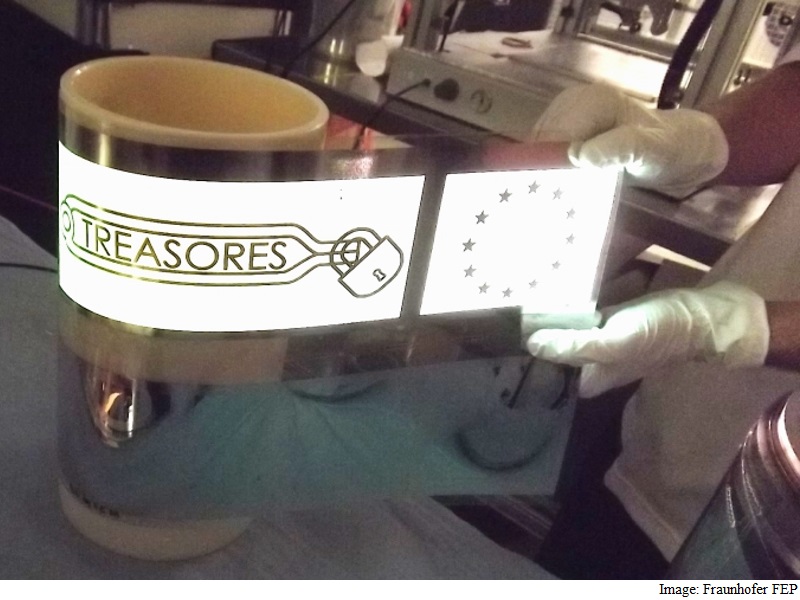- Home
- Science
- Science News
- New Electrodes, Barrier Materials to Power Next Generation Light Sources: Study
New Electrodes, Barrier Materials to Power Next-Generation Light Sources: Study

Researchers developed the new technology for use in the next generation of flexible optoelectronics as part of the TREASORES project of the European Union.
TREASORES stands for transparent electrodes for large area large scale production of organic optoelectronic devices.
"I am very much looking forward to seeing the first commercial products made using materials from the project in 2016", said Frank Nuesch from the Swiss Federal Laboratories for Materials Science and Technology (Empa), who led the TREASORES project.
The new electrodes have been tested with several types of optoelectronic devices and are believed to make light sources and solar cells much cheaper in future, according to Empa.
The electrodes from the project are technically at least as good as those currently used (made from indium tin oxide, ITO) but will be cheaper to manufacture and do not rely on the import of indium.
Tomasz Wanski from the Fraunhofer Institute for Organic Electronics, Electron Beam and Plasma Technology said that because of the new electrodes, the Oled light source was very homogeneous over a large area, achieving an efficiency of 25 lumens per watt.
In the course of the project, new test methods were developed by the National Physical Laboratory in Britain to make sure that the electrodes would still work after being repeatedly bent - a test that may become a standard in the field.
A further outcome of the project has been the development, testing and production scale-up of new approaches to transparent barrier foils (plastic layers that prevent oxygen and water vapour from reaching the sensitive organic electronic devices).
High performance low-cost barriers were produced and it is expected that the Swiss company Amcor Flexibles Kreuzlingen will adopt this technology after further development.
Such high performance barriers are essential to achieve the long device lifetimes that are necessary for commercial success - as confirmed by a life cycle analysis (LCA) completed during the project, solar cells are only economically or ecologically worthwhile if both their efficiency and lifetime are high enough.
By combining the production of barriers with electrodes (instead of using two separate plastic substrates), the project has shown that production costs can be further reduced and devices made thinner and more flexible.
For the latest tech news and reviews, follow Gadgets 360 on X, Facebook, WhatsApp, Threads and Google News. For the latest videos on gadgets and tech, subscribe to our YouTube channel. If you want to know everything about top influencers, follow our in-house Who'sThat360 on Instagram and YouTube.
Related Stories
- Samsung Galaxy Unpacked 2025
- ChatGPT
- Redmi Note 14 Pro+
- iPhone 16
- Apple Vision Pro
- Oneplus 12
- OnePlus Nord CE 3 Lite 5G
- iPhone 13
- Xiaomi 14 Pro
- Oppo Find N3
- Tecno Spark Go (2023)
- Realme V30
- Best Phones Under 25000
- Samsung Galaxy S24 Series
- Cryptocurrency
- iQoo 12
- Samsung Galaxy S24 Ultra
- Giottus
- Samsung Galaxy Z Flip 5
- Apple 'Scary Fast'
- Housefull 5
- GoPro Hero 12 Black Review
- Invincible Season 2
- JioGlass
- HD Ready TV
- Laptop Under 50000
- Smartwatch Under 10000
- Latest Mobile Phones
- Compare Phones
- Moto G15 Power
- Moto G15
- Realme 14x 5G
- Poco M7 Pro 5G
- Poco C75 5G
- Vivo Y300 (China)
- HMD Arc
- Lava Blaze Duo 5G
- Asus Zenbook S 14
- MacBook Pro 16-inch (M4 Max, 2024)
- Honor Pad V9
- Tecno Megapad 11
- Redmi Watch 5
- Huawei Watch Ultimate Design
- Sony 65 Inches Ultra HD (4K) LED Smart TV (KD-65X74L)
- TCL 55 Inches Ultra HD (4K) LED Smart TV (55C61B)
- Sony PlayStation 5 Pro
- Sony PlayStation 5 Slim Digital Edition
- Blue Star 1.5 Ton 3 Star Inverter Split AC (IC318DNUHC)
- Blue Star 1.5 Ton 3 Star Inverter Split AC (IA318VKU)

















